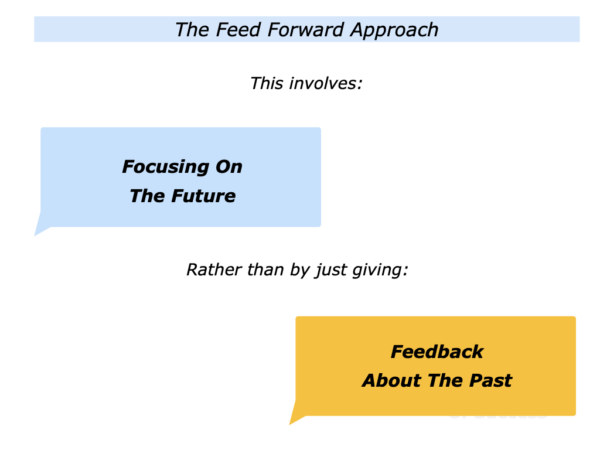
There are many ways to help people to develop. This piece describes how it is possible to use the feed forward approach rather than just the feedback approach. It helps people to focus on the future rather than just the past.
The term feed forward is used by a colleague of mine, Luke Judge. It is an approach that has been used in education and also by coaches such as Marshall Goldsmith. Let’s explore these different approaches.
The Feedback Approach
– Focusing On The Past
Some organisations tell their people to continually give feedback on ideas and performance. This approach has both pluses and minuses.
The Potential Pluses
These include the following. When done properly, it can help to provide a reality check. This may particularly be the case when focusing on how to improve products or relationships with customers.
The Potential Minuses
These can include the following. Many of these relate to people giving each other feedback.
The feedback that is given may say as much about the person giving it as the person they are giving it to. It may reflect their view of the world.
The feedback may be emotional and based individual feelings. It may not give a reality check that also gives specific examples.
The feedback may only be past focused and critical. It may not give a positive way forward that can help other people to improve.
Such an approach can work but there are pitfalls. This is especially the case when it comes to performance management sessions. People may not look forward to the sessions or find them rewarding. Such sessions can also be challenging if the manager:
Is telling people they must work well together to help each to succeed;
Is also told by their organisation that they must distribute people’s performance across some imaginary Bell Curve.
The Bell Curve approach does not necessarily apply to great teams. It also gives people double messages. They are supposed to cooperate but will also be measured against each other.
The Feed Forward Approach
– Focusing On The Future
Some organisations take this approach. This involves encouraging their people:
To focus on the real results to achieve and the benefits of achieving the picture of success;
To focus on what they can keep doing – such as the things they do well –to do their best to achieve the picture of success;
To focus on what they can add or do differently to increase the chances of achieving the picture of success.
When appropriate, it is also possible for the person and their manager to assess their performance in terms of achieving the previously agreed goals. That process is described in a pack I have produced called The Performance Management Pack.
That pack canbe sent to you on request. It provides practical tools that both the manager and team member can use to hold a rewarding performance management session.
Let’s return to the feed forwards approach. Imagine that you are a leader who is going to meet a person to agree on their action plan for achieving certain goals. One approach is to work through the following themes.
You Can Focus On
The Picture Of Success
You may have already had a session where you and the person assessed how they had performed in relation to achieving their previously agreed goals. When appropriate, it can then be useful to say something along the following lines.
Let’s move on to focusing on the future. As you know, the specific results the team needs to deliver by a certain date are the following:
To …
To …
To …
Bearing in mind your strengths, what are the specific results you would like to deliver towards achieving the team’s goals?
There may be other things we need to add later, but let’s start with what you see as your best contribution to the team. We can then focus on the strategies you can follow to this picture of success.
Imagine that you have had a conversation with the person about their best contribution. This part of the session may conclude the person completing the following framework.
The Picture Of Success: The
specific results I aim to deliver by … are:
*
*
*
Let’s assume you and the person have agreed on their goals. Bearing these in mind, it can then be useful to explore how they can do their best to achieve these aims.
There are many ways to take this step. One approach is to start by exploring the following theme.
You Can Focus On What
The Person Can Keep Doing
Great workers build on what they are doing well. They keep following these principles and to consistently deliver 7+/10. They may then add other things to get them closer to 10/10.
How to take this step? One approach is to encourage the person to focus on what they can keep doing. They can then continue to follow these good habits to perform good work.
Some people may need help to build on these strengths. This may be because they – and perhaps others – immediately identify their shortcomings rather what they can keep doing to create a platform for success.
Imagine you are helping a person to clarify what they are doing well. Much depends on their role, of course, but here are some of the things that they and you may describe.
Keep Doing – The
Person Can Continue:
To keep focusing on the picture of success … To keep providing good leadership for their own team … To keep providing great service to their customers … To keep delivering high quality work.
Let’s assume the person has identified what they can keep doing. If appropriate, you can then move on to the next stage.
You Can Focus On What The
Person Can Add Or Do Differently
Great workers focus on continuous improvement. One leader described how they encouraged people to do this in a positive way. They said:
“I begin by encouraging the team member to keep building on what they do well. This can build their confidence and create a platform for achieving success.
“Bearing in mind the results they aim to achieve, I then invite the person to take time to reflect and do the following exercise.
Adding Or Doing Differently
The specific things I can add or do differently to increase
the chances of achieving the picture of success are:
*
*
*
This approach often results in a person adding several skills or fresh habits they can pursue to achieve their goals. But this also raises another question:
What happens if the person does not mention something they probably need to add or do differently to achieve the desired results?
Sometimes it is necessary to give a reality check. When doing so, you can follow certain principles to increase the possibility of a person taking the ideas on board. One approach can be to say something along the following lines.
Bearing in mind the goals to achieve, you have explored what you can add or do differently. Is it okay for me to share some ideas you may also want to consider to help you achieve the picture of success?
The person will probably say that it would be okay for you to share ideas. If so, you may say something along the following lines.
Looking at the goals you want to achieve, here are some possibilities you may wish to consider.
One idea would be to … The benefits of doing this could be …
Another idea would be … The benefits of doing this could be …
Take time to consider what you may want to add or do differently to increase the chances of achieving the picture of success. Then add any of these to your action plan.
This approach can increase the chances of a person applying the ideas. If appropriate, you can then provide the support they may need to implement them successfully.
The language used here is important. It invites a person a focus on what they want to add of do differently rather than change.
Some people will argue that is comes down to semantics. But people prefer to develop rather be told they need to change. The language used here can increase the chance of them continuing to develop.
Let’s assume you have worked through some of the stages we have described. It may then be time to move on to the next stage.
You Can Focus On The Person’s Action
Plan For Achieving The Picture Of Success
When appropriate, you can invite the person to take time to reflect and make their action plan for achieving the desired results. They can then share this with you.
Different people make action plans in different ways. Whatever approach they use, however, it can be useful for them to describe:
The specific results they aim to deliver – the picture of success;
The specific strategies they will follow to deliver the results;
The specific support they would like to help them deliver the results;
The specific things they will do to proactively keep people informed about their progress towards delivering the results;
The specific things that will be happening that will show they have achieved the picture of success.
Imagine that the person has completed their agreed action plan. You can then have regular sessions with them where they can update you on their progress towards achieving the picture of success.
There are many ways to help a person to continue to do fine work and develop. This piece has described one approach that involves focusing on the future.
The following section provides a summary of the steps you can take when following this approach. You will obviously apply these in your own way when helping the person and your team to achieve success.
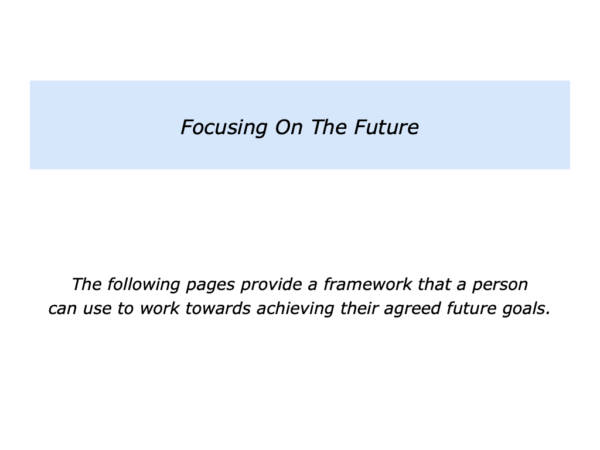
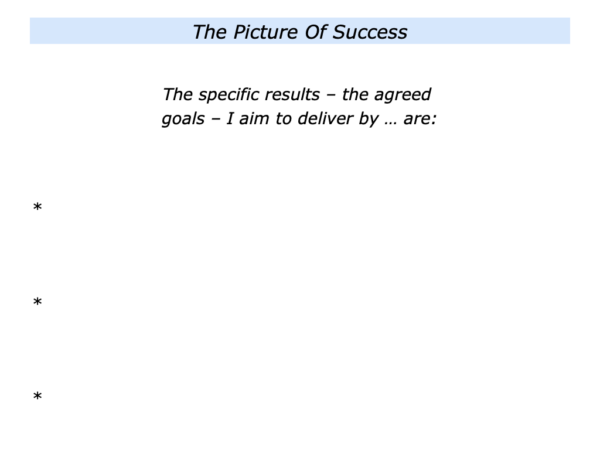
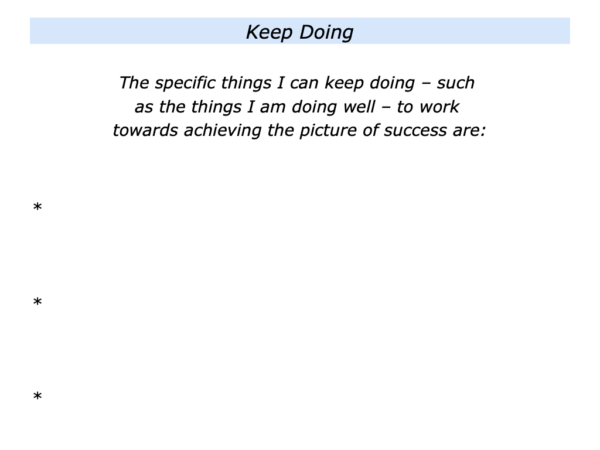
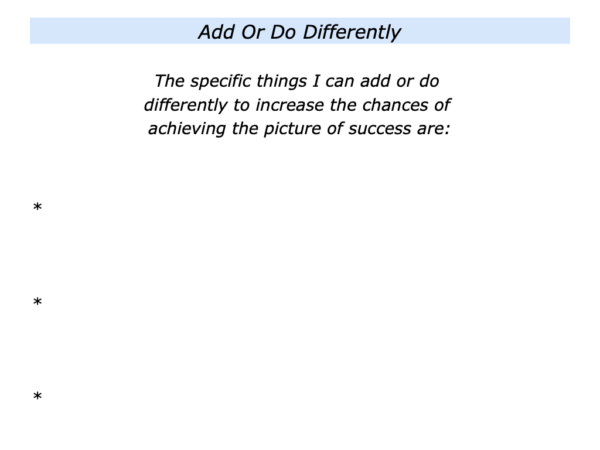
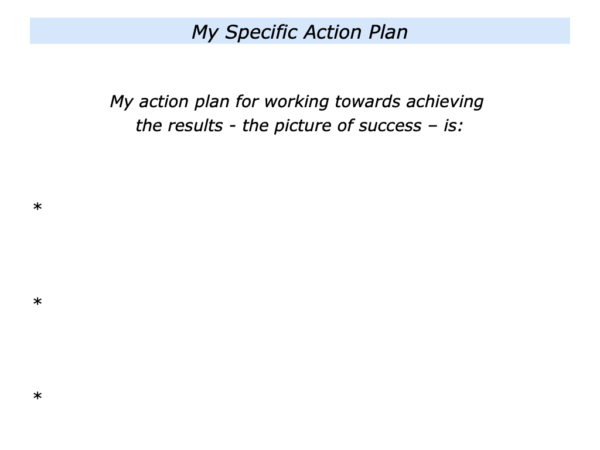






Leave a Reply